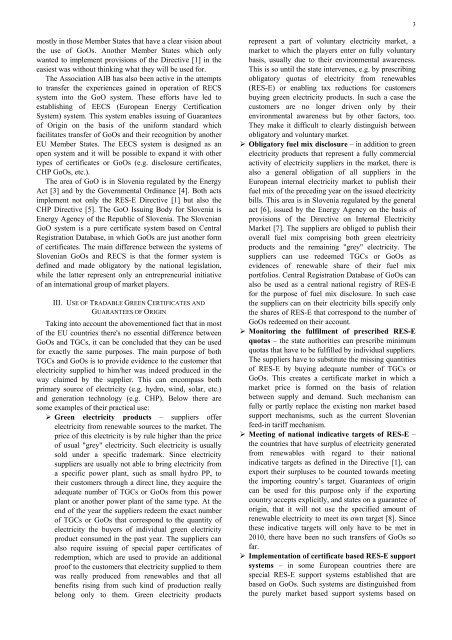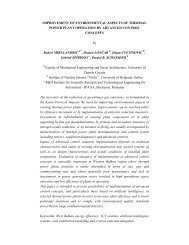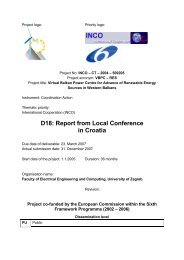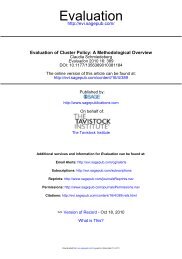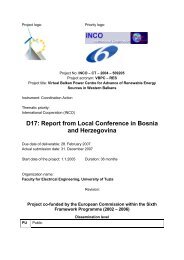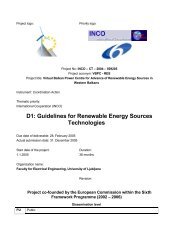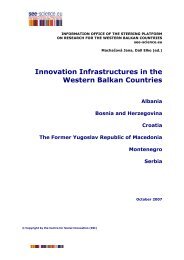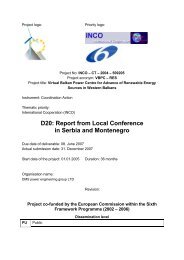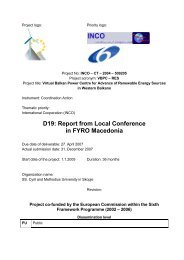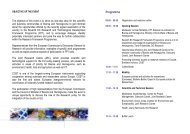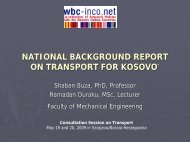Prva stran - WBC-INCO Net
Prva stran - WBC-INCO Net
Prva stran - WBC-INCO Net
Create successful ePaper yourself
Turn your PDF publications into a flip-book with our unique Google optimized e-Paper software.
mostly in those Member States that have a clear vision about<br />
the use of GoOs. Another Member States which only<br />
wanted to implement provisions of the Directive [1] in the<br />
easiest was without thinking what they will be used for.<br />
The Association AIB has also been active in the attempts<br />
to transfer the experiences gained in operation of RECS<br />
system into the GoO system. These efforts have led to<br />
establishing of EECS (European Energy Certification<br />
System) system. This system enables issuing of Guarantees<br />
of Origin on the basis of the uniform standard which<br />
facilitates transfer of GoOs and their recognition by another<br />
EU Member States. The EECS system is designed as an<br />
open system and it will be possible to expand it with other<br />
types of certificates or GoOs (e.g. disclosure certificates,<br />
CHP GoOs, etc.).<br />
The area of GoO is in Slovenia regulated by the Energy<br />
Act [3] and by the Governmental Ordinance [4]. Both acts<br />
implement not only the RES-E Directive [1] but also the<br />
CHP Directive [5]. The GoO Issuing Body for Slovenia is<br />
Energy Agency of the Republic of Slovenia. The Slovenian<br />
GoO system is a pure certificate system based on Central<br />
Registration Database, in which GoOs are just another form<br />
of certificates. The main difference between the systems of<br />
Slovenian GoOs and RECS is that the former system is<br />
defined and made obligatory by the national legislation,<br />
while the latter represent only an entrepreneurial initiative<br />
of an international group of market players.<br />
III. USE OF TRADABLE GREEN CERTIFICATES AND<br />
GUARANTEES OF ORIGIN<br />
Taking into account the abovementioned fact that in most<br />
of the EU countries there's no essential difference between<br />
GoOs and TGCs, it can be concluded that they can be used<br />
for exactly the same purposes. The main purpose of both<br />
TGCs and GoOs is to provide evidence to the customer that<br />
electricity supplied to him/her was indeed produced in the<br />
way claimed by the supplier. This can encompass both<br />
primary source of electricity (e.g. hydro, wind, solar, etc.)<br />
and generation technology (e.g. CHP). Below there are<br />
some examples of their practical use:<br />
Green electricity products – suppliers offer<br />
electricity from renewable sources to the market. The<br />
price of this electricity is by rule higher than the price<br />
of usual "grey" electricity. Such electricity is usually<br />
sold under a specific trademark. Since electricity<br />
suppliers are usually not able to bring electricity from<br />
a specific power plant, such as small hydro PP, to<br />
their customers through a direct line, they acquire the<br />
adequate number of TGCs or GoOs from this power<br />
plant or another power plant of the same type. At the<br />
end of the year the suppliers redeem the exact number<br />
of TGCs or GoOs that correspond to the quantity of<br />
electricity the buyers of individual green electricity<br />
product consumed in the past year. The suppliers can<br />
also require issuing of special paper certificates of<br />
redemption, which are used to provide an additional<br />
proof to the customers that electricity supplied to them<br />
was really produced from renewables and that all<br />
benefits rising from such kind of production really<br />
belong only to them. Green electricity products<br />
represent a part of voluntary electricity market, a<br />
market to which the players enter on fully voluntary<br />
basis, usually due to their environmental awareness.<br />
This is so until the state intervenes, e.g. by prescribing<br />
obligatory quotas of electricity from renewables<br />
(RES-E) or enabling tax reductions for customers<br />
buying green electricity products. In such a case the<br />
customers are no longer driven only by their<br />
environmental awareness but by other factors, too.<br />
They make it difficult to clearly distinguish between<br />
obligatory and voluntary market.<br />
Obligatory fuel mix disclosure – in addition to green<br />
electricity products that represent a fully commercial<br />
activity of electricity suppliers in the market, there is<br />
also a general obligation of all suppliers in the<br />
European internal electricity market to publish their<br />
fuel mix of the preceding year on the issued electricity<br />
bills. This area is in Slovenia regulated by the general<br />
act [6], issued by the Energy Agency on the basis of<br />
provisions of the Directive on Internal Electricity<br />
Market [7]. The suppliers are obliged to publish their<br />
overall fuel mix comprising both green electricity<br />
products and the remaining "grey" electricity. The<br />
suppliers can use redeemed TGCs or GoOs as<br />
evidences of renewable share of their fuel mix<br />
portfolios. Central Registration Database of GoOs can<br />
also be used as a central national registry of RES-E<br />
for the purpose of fuel mix disclosure. In such case<br />
the suppliers can on their electricity bills specify only<br />
the shares of RES-E that correspond to the number of<br />
GoOs redeemed on their account.<br />
Monitoring the fulfilment of prescribed RES-E<br />
quotas – the state authorities can prescribe minimum<br />
quotas that have to be fulfilled by individual suppliers.<br />
The suppliers have to substitute the missing quantities<br />
of RES-E by buying adequate number of TGCs or<br />
GoOs. This creates a certificate market in which a<br />
market price is formed on the basis of relation<br />
between supply and demand. Such mechanism can<br />
fully or partly replace the existing non market based<br />
support mechanisms, such as the current Slovenian<br />
feed-in tariff mechanism.<br />
Meeting of national indicative targets of RES-E –<br />
the countries that have surplus of electricity generated<br />
from renewables with regard to their national<br />
indicative targets as defined in the Directive [1], can<br />
export their surpluses to be counted towards meeting<br />
the importing country’s target. Guarantees of origin<br />
can be used for this purpose only if the exporting<br />
country accepts explicitly, and states on a guarantee of<br />
origin, that it will not use the specified amount of<br />
renewable electricity to meet its own target [8]. Since<br />
these indicative targets will only have to be met in<br />
2010, there have been no such transfers of GoOs so<br />
far.<br />
Implementation of certificate based RES-E support<br />
systems – in some European countries there are<br />
special RES-E support systems established that are<br />
based on GoOs. Such systems are distinguished from<br />
the purely market based support systems based on<br />
3


